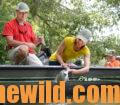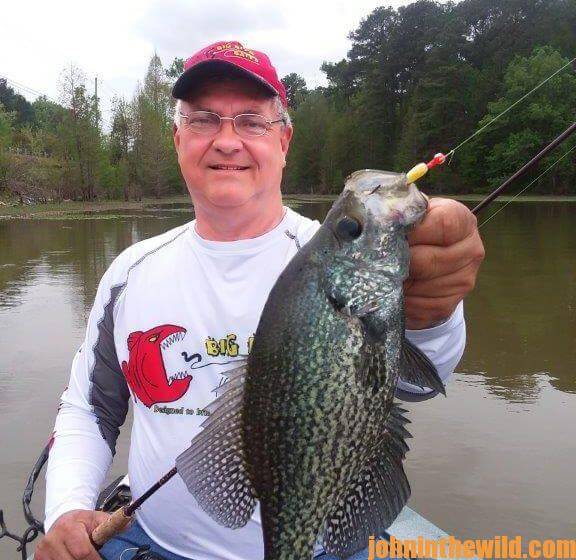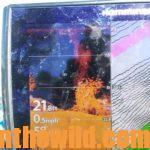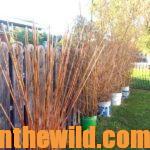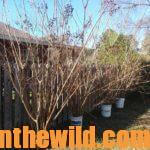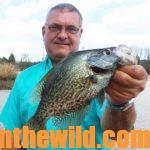Editor’s Note: “The fastest I’ve ever finished a two-angler limit of 60 crappie was 45 minutes,” Tony Adams, a crappie farmer on Alabama’s Lake Eufaula on the Chattahoochee River, explains. “Catching 60 crappie in 1-1/2 hours isn’t uncommon, and most of the time from April to October, my two fishermen will catch their 60-crappie limit – 30 each – in 3-1/2 hours or less.” As the great baseball player Dizzy Dean once said, “If you’ve done it, it ain’t bragging,” and I’ve seen Adams do it. In the movie, “Field of Dreams,” the voice in Kevin Costner’s head told him, “Build it and they will come,” so, he built a baseball field in the middle of an Iowa corn field that people paid to come and see. Tony Adams builds crappie condos throughout Lake Eufaula to provide places to fish and catch crappie. He also pre-scouts his underwater structures before trips to identify locations with the most crappie on them. We asked Adams how, where and with what he builds these underwater structures for crappie fishing and why he puts them out. You can use these same tactics to make your crappie lake a reliable place for you to find and catch crappie throughout the year.
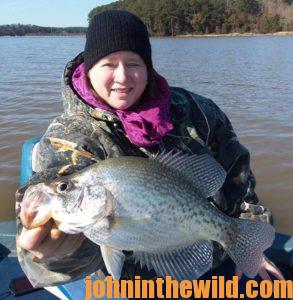 * John E. Phillips: If you’re sinking 100 buckets of structure and putting in 10-20 trees a year, are you building all-new structure every year?
* John E. Phillips: If you’re sinking 100 buckets of structure and putting in 10-20 trees a year, are you building all-new structure every year?
Tony Adams: No, I’m not. I have all my crappie spots on a three-year rotation. I usually try and refresh my spots every three years, and when I say refresh, that means sink a new structure around the old structure to give that spot new life and to have structure in the same place where I’ve captured crappie in the past and continue to attract crappie. Or, if I have built a little crappie-habitat spot with perhaps only five buckets, I may want to go back in and make that spot bigger. My depth finder will tell me how long that structure has been in the water. Each year I mark spots on my depth finder where I sink new buckets or additional structure or an established site with a different-colored waypoint marker. For instance, the waypoints I put out in 2001, I marked with yellow. In 2000, I marked all the waypoints with structure with blue. In 1999, I marked the structure waypoints with green. That’s the way I can keep up with when I need to refurbish that site by adding additional buckets or additional trees. In a year, I’ll probably create 20-new spots by having my depth finder on and looking for productive areas to place crappie habitat. The other 80 buckets I’ll use to refurbish spots that are three years old or older. Not all my locations will produce crappie ever year, and if I have a spot where I haven’t seen or caught any crappie, then I may let that spot die and not refurbish it. Instead, I’ll use my habitat to increase the size of a region that’s producing big numbers of good crappie. If I’m riding around and pinpoint a stump underwater or on a point, and my depth finder shows me 8-15 crappie holding on that stump, then that’s where I’ll I build another fishing spot. Structure is there and is already attracting crappie. If I place more structure there, than I reasonably can believe that more crappie will hold there.
One important key to building new crappie spots is that every year, usually during the spring or fall at other U.S. lakes and Lake Eufaula too is – there are floods and high current passing through. Those floods bring new structure down the river and deposit stumps, logs and debris in places where structure never has been before and often move old structure from where it has been in the past. Often, the new structure will have crappie in it the minute the flood waters recede. When I first started putting structure in Lake Eufaula, I didn’t know anybody else adding structure in the bottom for crappie, but I’m sure others are doing it now.
 * Phillips: What about Lake Eufaula helps its crappie fishing be so good?
* Phillips: What about Lake Eufaula helps its crappie fishing be so good?
Adams: One of the advantages we have here at Lake Eufaula is that this lake is known far and wide as a big-bass lake. Because of that, everyone overlooks the crappie capabilities in Lake Eufaula. I didn’t start putting out structure in the lake to guide on that structure – I was just trying to learn a way to catch crappie when they weren’t spawning in the daytime or holding around the bridge pylons at night. I knew that all the crappie in the lake didn’t hibernate after the spawn and not bite. I felt like if I could find them throughout the year, then anytime I wanted a mess of crappie I could go catch them. When I started building spots in various water depths and locations, I learned how to pattern the crappie at different times of the year – especially during the hot summer months when most people wanted to fish for crappie but didn’t realize these fish would bite when the temperatures are 90-100 degrees.
When I first began fishing on Lake Eufaula, the limit on crappie was 50 fish per person per day, so with four people in the boat and in one night of crappie fishing, we’d catch 200 crappie. The challenge for me was how to pinpoint those crappie during the daylight hours of the summertime and how to catch them. Finally, I realized that if I could build habitat for crappie to stay at the depth the crappie were holding during the hot summer months, then I should be able to catch them. By trial and error, I learned to use structure to be able to locate and catch crappie at almost any time of the year. However, most of the people who fish with me fish after the spawn – usually mid-April all the way up until about November – I’m still chasing crappie and finding better ways to pinpoint them, concentrate them and catch them.
* Phillips: What problems have you had to overcome to catch crappie year-round?
Adams: My biggest problem to solve has been where the crappie go after the spawn, and at what depths they hold in after the spawn. Then I can use those same patterns in the fall when the crappie leave deep water, move up to the shallow water and locate crappie in the same places where I’ve found them in the spring. As the weather becomes cooler, I need to know at what depth of water the crappie have moved to, what type of structure they’ve stayed on before they’ve moved to even-deeper water, and what depth of water the crappie like to hold on as the weather gets colder.
 Currently I have crappie structure in water as shallow as 10 feet to as deep as 35 feet. I’ve also learned that on overcast days in the summer when the temperature is maybe 90 or 100 degrees, and you think the crappie will be in deep water, they may have moved up to 10 foot of water and start eating shad or minnows. Usually in June through September, if I’m on the water at daylight, I’ll often be able to catch crappie in 8-10 foot deep water, and the same is true if I’m fishing late in the afternoon just before dark. After about two hours in the morning, the crappie will move out to deeper water, 18-20 feet.
Currently I have crappie structure in water as shallow as 10 feet to as deep as 35 feet. I’ve also learned that on overcast days in the summer when the temperature is maybe 90 or 100 degrees, and you think the crappie will be in deep water, they may have moved up to 10 foot of water and start eating shad or minnows. Usually in June through September, if I’m on the water at daylight, I’ll often be able to catch crappie in 8-10 foot deep water, and the same is true if I’m fishing late in the afternoon just before dark. After about two hours in the morning, the crappie will move out to deeper water, 18-20 feet.
* Phillips: What bait do you use to catch crappie?
Adams: I usually can catch crappie on minnows, jigs and spoons and have found that as long as I can have something a crappie may eat in front of its nose, the fish usually will eat it.
* Phillips: What type of line do you use?
Adams: I’m often fishing a 2-4 pound Hi-Vis (high visibility line) monofilament line. If I’m minnow fishing, I’ll put my lead about 8-10 inches above my hook. Then the minnows can swim freely, regardless of the water depth I’m fishing.
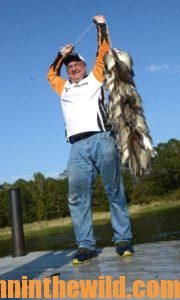 * Phillips: How long after you sink structure before crappie find it, and you can catch them?
* Phillips: How long after you sink structure before crappie find it, and you can catch them?
Adams: That time varies. I’ve started sinking structure in the morning before, finish up at 10:00 or 11:00 am, return with my depth finder and see crappie holding on that first structure I’ve sunk earlier that morning. I usually don’t plan to fish my new structure for three months to a year – just depending on how quickly the crappie have found the structure.
* Phillips: How many spots on Lake Eufaula do you have where you can catch crappie?
Adams: Over 2,000 places. I’ve been building crappie spots for 30 years, and I usually put out 100 buckets or trees every year during the winter.
To get in touch with Adams, call him at (334) 695-3003, or go to his Facebook page, “Gone Fishing with Tony Adams” at https://www.facebook.com/Gone-Fishing-With-Tony-133709770592006/ and see where he posts pictures every day that he takes anglers out fishing.
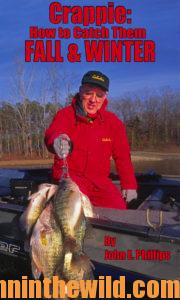 To learn more about crappie fishing in the fall and winter, check out John E. Phillips’ book, “Crappie: How to Catch Them Fall & Winter,” available in Kindle, print and Audible at https://www.amazon.com/gp/product/B00GDP0W2C/ref=dbs_a_def_rwt_hsch_vapi_taft_p1_i3.
To learn more about crappie fishing in the fall and winter, check out John E. Phillips’ book, “Crappie: How to Catch Them Fall & Winter,” available in Kindle, print and Audible at https://www.amazon.com/gp/product/B00GDP0W2C/ref=dbs_a_def_rwt_hsch_vapi_taft_p1_i3.
You may have to cut and paste this link into your browser. (When you click on this book, notice on the left where Amazon says you can read 10% of this book for free and hear 10% for free).


